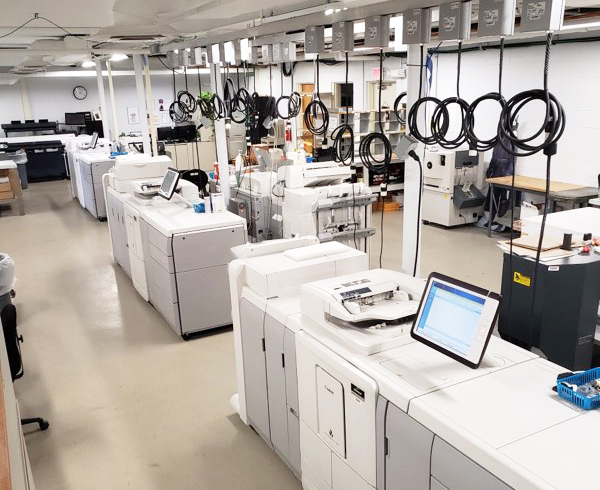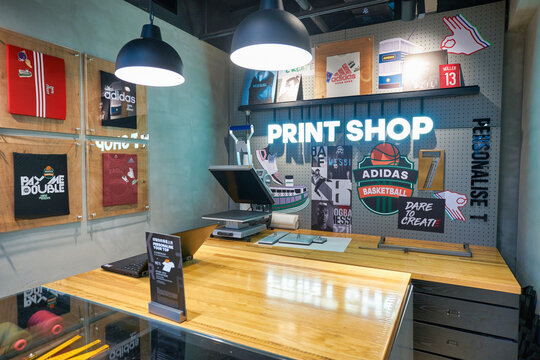3 Types of Printing Every Print Shop Near Me Should Offer
3 Types of Printing Every Print Shop Near Me Should Offer
Blog Article
The Ultimate Guide to Utilizing Printing Services for Personalized Art Prints
Steering via the globe of personalized art prints calls for a clear understanding of various printing services. Musicians need to think about variables such as printing strategies and materials to achieve the desired result. Each decision, from art work prep work to color calibration, plays a necessary role in the end product. As they check out these aspects, musicians can expose the possibility for their work to connect with audiences in a significant method. What steps can they require to ensure their prints stand apart?
Understanding Various Sorts Of Printing Solutions
Although lots of people may ignore the complexities of printing solutions, understanding the various kinds offered is vital for any individual aiming to develop custom-made art prints. The most typical types include electronic printing, offset printing, and screen printing. Digital printing is favored for its quick turnaround and capability to generate high-grade images directly from digital documents, making it perfect for tiny runs. In contrast, offset printing deals remarkable picture high quality and is cost-efficient for bigger quantities, using plates to transfer ink onto paper. Screen printing, commonly used for textiles and advertising products, includes pushing ink through a mesh screen, enabling vivid colors and textures. Each technique has its distinct benefits and limitations, making it crucial for musicians and developers to assess their particular needs, such as amount, desired top quality, and spending plan, prior to picking a printing service that lines up with their artistic vision.
Picking the Right Products for Your Prints
Picking the proper materials is necessary for attaining premium custom art prints. Understanding the various kinds of paper and the importance of ink top quality can significantly influence the outcome. Musicians need to take into consideration these factors to ensure their vision is accurately represented in the printed item.
Paper Types Explained
Picking the ideal paper type is necessary for achieving the desired visual and resilience in personalized art prints. Various alternatives exist, each offering distinct attributes. Shiny paper enhances color vibrancy and information, making it suitable for photography prints. Conversely, matte paper provides a softer surface, which is more suitable for art work that requires subtlety and structure. Great art paper, typically made from cotton or alpha cellulose, provides historical high quality and is appropriate for replicating intricate information in paints (Print Shop Near Me). In addition, specialized documents, such as watercolor or canvas, can include one-of-a-kind visual results. Eventually, picking the proper paper kind will considerably influence the final presentation, making sure that the art work is both long-lasting and visually attractive
Ink High Quality Matters
Ink high quality plays an important duty in the overall success of custom art prints. High-quality inks ensure dynamic colors, sharp information, and longevity, which are vital for showcasing creative work. When choosing printing services, artists should take into consideration pigment-based inks over dye-based alternatives, as they provide far better fade resistance and color stability. Additionally, the choice of ink must complement the chosen paper kind, boosting the print's aesthetic effect. Environmental factors, such as moisture and temperature, can likewise impact ink efficiency; consequently, musicians should inquire about ink solutions that resist these components. Inevitably, spending in remarkable ink high quality can elevate the last item, guaranteeing that the art print continues to be real to the artist's vision for many years to come.
Checking Out Printing Strategies: Digital vs. Typical
While both traditional and electronic printing methods have their unique advantages, the decision on which approach to make use of frequently rests on the details demands of the art work. Digital printing stands out in flexibility and speed, enabling fast turn-around times and the capability to publish on need. This method is specifically valuable for musicians who call for special items or tiny runs, as it gets rid of the demand for considerable configuration processes.Conversely, conventional printing strategies, such as lithography and display printing, commonly create richer shades and structures, interesting musicians seeking a more tactile and genuine surface. These methods can enhance the depth and high quality of the art work, making them appropriate for larger editions. In addition, traditional techniques might supply a distinctive aesthetic that digital printing sometimes struggles to replicate. Ultimately, the choice between these methods need to consider aspects like wanted high quality, quantity, and creative intent, guiding musicians to the most suitable option for their tasks.

Preparing Your Art Work for Printing
Efficiently preparing artwork for printing calls for mindful interest to detail, regardless of the picked printing method. Musicians need to guarantee that their data are created at the proper resolution, commonly 300 DPI, to preserve sharpness and clearness. The correct shade setting, typically CMYK for print, is vital to achieve the desired color precision. Artists should additionally think about the dimensions of the art work, ensuring to consist of hemorrhage areas if essential, to avoid any kind of unwanted white sides after trimming.Additionally, file formats play a vital duty; TIFF and PDF are usually preferred for high-quality prints. Before entry, it is very important to evaluate the artwork for any blemishes or unwanted components. By diligently examining these facets, artists can enhance the probability of their prints straightening with their creative vision, inevitably causing an effective printing result.
The Importance of Color Calibration and Proofing
Shade calibration and proofing are important action in the printing procedure, as they guarantee that the final result properly shows the artist's vision. Appropriate shade calibration guarantees that the colors showed on important site the screen suit those that will certainly be printed. This process includes changing the display settings, printer profiles, and inks to attain a regular color representation.Additionally, proofing enables musicians to sneak peek their work prior to the final print run. This stage allows them to find and correct any kind of disparities in saturation, shade, or information, thus lessening expensive mistakes. By making use of digital or hard-copy evidence, artists can make educated decisions about modifications required for excellent results.Incorporating shade calibration and proofing right into the printing process not only improves the high quality of the end product yet also cultivates a reputable collaboration in between the musician and the printing solution, ensuring satisfaction and fidelity to the initial artwork.
Choosing the Perfect Size and Layout for Your Prints

Advertising and Selling Your Custom Art Prints
Advertising and selling customized art prints needs a solid brand identity to stick out in an open market. Efficient online promo approaches and the calculated usage of social media platforms can substantially enhance visibility and interaction. By integrating these aspects, artists can produce a compelling existence that attracts potential purchasers.
Structure Your Brand Name Identification
Establishing a solid brand identification is necessary for artists wanting to efficiently market and market their custom-made art prints. This identity includes the musician's one-of-a-kind design, worths, and story, which reverberate with possible buyers. Artists need to produce a natural visual visibility across all platforms, consisting of logos, color plans, and typography that mirror their creative vision. Furthermore, a clear objective declaration aids communicate the musician's function and passion. Engaging narration concerning the motivation behind each piece can foster psychological links with the target market. Consistency in messaging, whether on social networks or product packaging, improves acknowledgment and trust fund. By thoroughly curating their brand name identification, musicians can differentiate themselves in an open market, bring in devoted customers that value their creativity.
Efficient Online Promo Techniques
What strategies can artists utilize to efficiently advertise their customized art publishes online? Creating an expert internet site showcasing the artwork is important. This site should include high-grade images and in-depth descriptions to engage possible purchasers. In addition, musicians can make use of e-mail advertising and marketing by developing a subscriber list to share updates, promotions, and brand-new launches. Teaming up with blog owners and influencers in the art community can expand reach and credibility. Providing special pieces or limited-time discounts can likewise develop seriousness, encouraging acquisitions. In addition, enhancing web content for search engines via relevant key words will improve exposure. Keeping a blog regarding the creative procedure can draw in art lovers, promoting a deeper connection with the target market and improving the total advertising strategy.
Using Social Media Platforms
Social network platforms serve as powerful tools for artists wanting to market and sell their personalized art prints. By leveraging systems like Instagram, Facebook, and Pinterest, artists can display their work to a vast target market. Involving visuals and calculated hashtags can enhance visibility, attracting potential buyers to their accounts. Routinely publishing content, such as brand-new styles or behind-the-scenes like it procedures, helps maintain target market interest and fosters a sense of community. Additionally, artists can utilize targeted advertising to get to particular demographics, improving the opportunities of sales. Partnerships with influencers or other artists can further intensify direct exposure. Inevitably, a well-curated social media presence not only advertises customized art prints but likewise constructs a loyal consumer base gradually.
Regularly Asked Concerns

How Do I Find Trusted Printing Solution Providers?
To find dependable printing provider, one ought to look into online testimonials, seek suggestions from peers, contrast portfolios, request samples, and evaluate client service responsiveness. This extensive approach guarantees informed choices and acceptable results.
What Is the Regular Turn-around Time for Personalized Prints?
The normal turnaround time for custom prints differs by service provider, but usually ranges from a couple of days to two weeks. Elements affecting this include order size, intricacy, and the details printing methods made use of.
Can I Get a Reimbursement if I'm Not Pleased With My Prints?
The question of getting a refund for disappointing prints frequently depends on the particular printing service's plans. Numerous companies offer fulfillment warranties, while others may have rigorous return conditions, emphasizing the relevance of examining terms beforehand.
Exist Any Hidden Costs Connected With Printing Providers?
Several printing solutions may consist of surprise costs such as setup charges, delivery charges, or service charges for certain materials. It's essential for clients to ask about all possible costs prior to finalizing their order.
Just How Can I Guarantee My Prints Are Eco-friendly?
To guarantee prints are eco-friendly, one should select environment-friendly inks, recycled paper, and lasting printing methods. Looking into printing solutions that prioritize sustainability and obtaining certifications can further ensure minimal ecological influence in the printing procedure. Guiding through the globe of custom-made art prints requires a clear understanding of numerous printing solutions. Lots of individuals may ignore the details of printing solutions, comprehending the different types readily available is vital for anyone looking to create personalized art prints. The most typical kinds include electronic printing, offset printing, and screen printing. Effectively preparing artwork for printing needs cautious attention to detail, no matter of the chosen printing strategy. Prints intended at galleries may call for common sizes to facilitate framing, whereas distinct formats may appeal to collection agencies looking for something distinctive.Lastly, the printing solution's abilities have to be examined.
Report this page